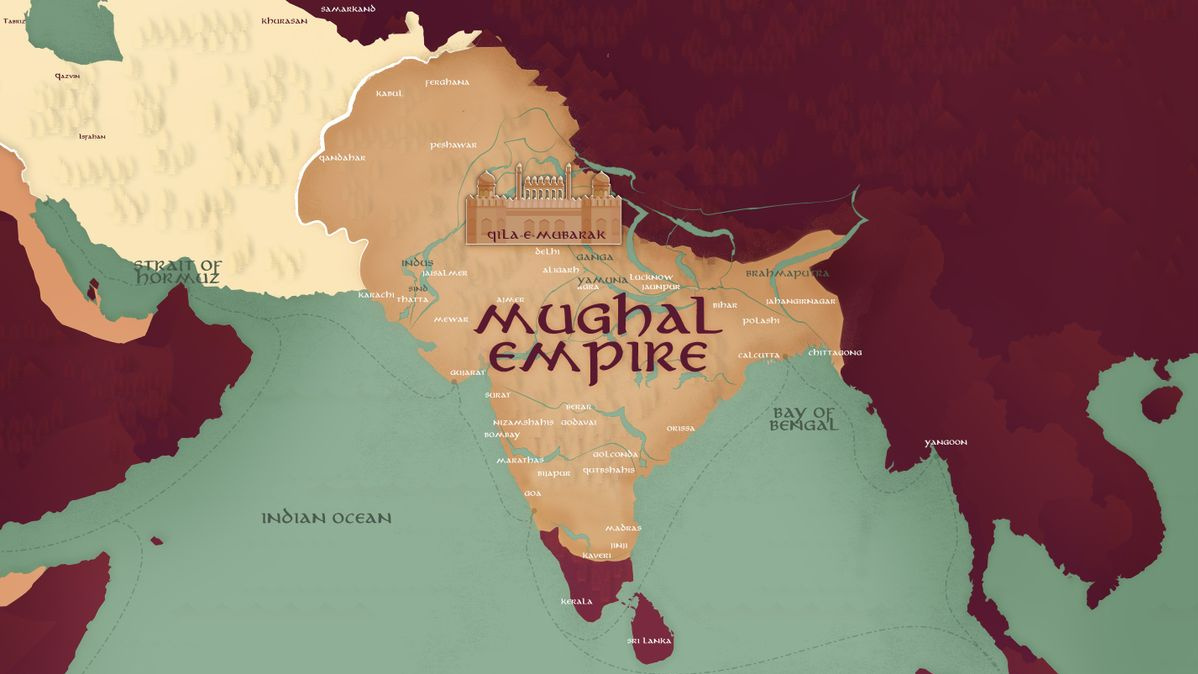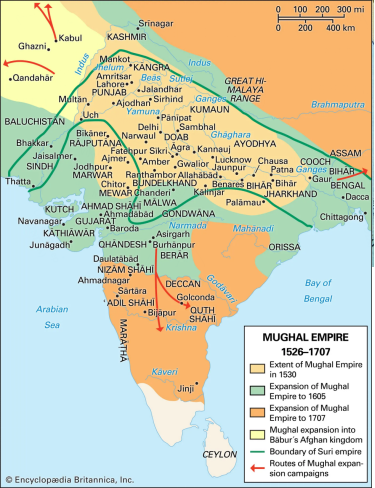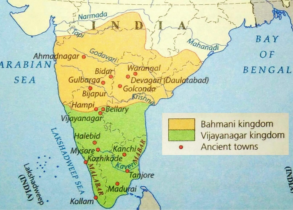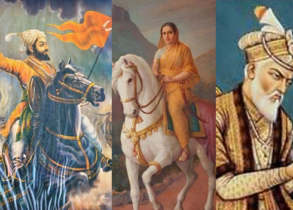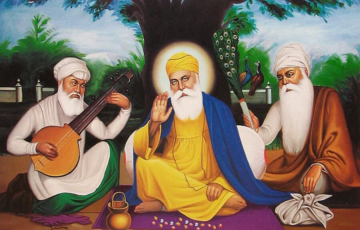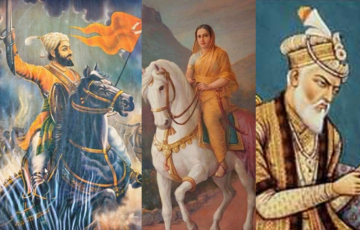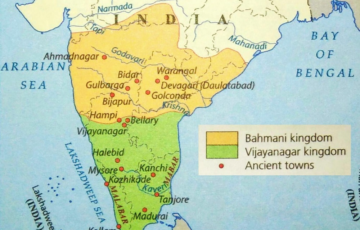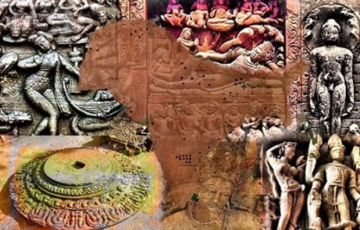MUGHAL EMPIRE
BABUR (1526-1530 AD)
- Babur’s lineage can be traced back to Turko-Mongol conquerors Timur and Chengiz Khanthrough his paternal and maternal lines respectively.
- He inherited the ambition to conquer Samarkandfrom his father, but financial strain and Uzbek threats prompted him to consider India as a refuge and strategic base.
- The political instability in India and discontent among Afghans and Rajputs against Ibrahim Lodi facilitated his conquest.
- Babur’s victory over the Lodis and the Rajput Confederacy reunited Kabul and Qandhar with Northern India, providing strategic security and integrating India with trans-Asian trade networks.
Major conquests in India:
- First Battle of Panipat (1526):Babur conquered Delhi and Agra, aiming to subdue the Rajputs and Afghans.
- Battle of Khanwa (1527):Fought against Rana Sanga and others, Babur took the title of Ghazi after this war.
- Battle of Chanderi (1528):Resulted in Babur’s victory over Medini Rai of Chanderi in Malwa.
- Battle of Ghagra (1529): Babur’s final battle against the Afghans, although he died in 1530 during his journey from Agra to Lahore.
Military and Warfare:
- Babur effectively used cannons, introducing them first time in India in sixteenth- century warfare.
- He implemented the Tulguma system, dividing the army into various units, during the first battle of Panipat.
- Controlling theKhyber Pass provided Babur with a consistent supply of high-quality horses, enhancing Mughal military capabilities.
Architecture:
- Introduced the Char Bagh, a Persian-style garden layout.
- Constructed mosques in Panipat and Sambhal.
Literature:
- His autobiography, Tuzuk-i-Baburi (Baburnamah), provides insights into his military strategies and reflects his fondness for Indian land.
- Babur’s tradition of keeping memoirs was followed by his successors in India.
- Proficient in Persian and Arabic.
Religious views:
- Despite being an orthodox Sunni, Babur maintained an open-minded approach.
- He was devoted to the Naqshbandiyya Sufi Khwaja Ubaidullah Ahrar.
| Important Facts
● Alam Khan, who invited Babur to invade India, was the uncle of Ibrahim Lodi and a pretender to the throne of Delhi. ● The Mughal ruler of medieval India belonged to the Chagatai Turk branch. ● Babur was defeated in the Battle of Sar-e-Pul by Shaibani Khan. ● Artillery was first used in the Battle of Panipat. ● The arrival of Babur in India led to the establishment of the Timurid dynasty in the region. ● Babur declared ‘Jehad’ in the Battle of Khanwa. ● Rana Sanga fought against Babur in the Battle of Khanwa. ● Zahiruddin Muhammad adopted the name Babur after becoming the Mughal Ruler in India. ● Babur adopted the title of ‘Padshah’ first at Kabul. ● The empire of Babur included Kabul, Punjab, and modern Uttar Pradesh. ● Babur mentioned Mewar as a Hindu state in his Babur Nama. ● Babur wrote his memoirs, Tuzuk-i-Baburi, in the Turkish language. ● The Babri mosque in Ayodhya was built by Mir Baqi. ● Babur circulated the silver coin called ‘Shahrukh’ during his rule. |
HUMAYUN (1530-1540 & 1555-1556 AD)
- Humayun succeeded Babur in 1530, inheriting unconsolidated administration and financial instability.
- Fragmented authority was evident as his brother Kamran governed Kabul, Qandahar, and Punjab.
Major conquests in India:
- Siege of Chunar (1532): Humayun defeated the Afghans at Dardah and besieged Chunar fort, a crucial stronghold.
- Battle of Chausa (1539):Faced defeat against Sher Shah Suri, narrowly escaping the battlefield.
- Battle of Kannauj (1540):Suffered a complete defeat, leading to Sher Shah Suri’s establishment of independent rule.
Humayun on exile (1540-1555):
- Took refuge inAmarkot, where Akbar was born in 1542.
- Traveled to Iran seeking assistance from Safavid Shah.
- Returned to India in 1555, defeating the Afghans with support from Bairam Khan and reclaimed Delhi.
Art and Architecture:
- Built Dinapanah,a new city in Delhi.
- Constructed the Jamali mosqueand mosque of Isa Khan in Delhi.
- Initiated the construction of Humayun’s Tomb, started by his wife, Hamida Benu Begum.
- Established the foundation of Mughal painting while in Persia, bringing renowned painters Mir Sayyid Ali and Abdal Samad to India.
- Founded the Nigaar Khana, a painting workshop, within his library.
- His sister Gul Badan Begum authored “Humayun-Nama.”
- Initiated the illustration project of Hamza Nama, continued by Akbar.
| Important Facts
● Humayun was the first ruler to issue a gold coin after the downfall of the Delhi Sultanate. ● Humayun invaded Chunar Fort for the first time in 1532. ● Haji Begum, the wife of Humayun, constructed his mausoleum at Delhi. |
SHER SHAH SURI (SUR EMPIRE) (1540-1555 AD)
Farid, also known as Sher Khan, hailed from the Jaunpur kingdom and earned the title of Sher Khan after defeating a tiger.
Conquests:
- In 1540, he defeated Humayun, establishing the second Afghan Empire in India.
- His conquests expanded to Malwa, Ranthambore, Raisen, Chittor, and Kalinjar.
- Tragically, Sher Shah died in 1545 due to an accidental gunpowder blast while besieging the Kalinjar fort.
Administration:
- Instituted a highly centralized government with key ministers overseeing revenue, finance, army, foreign affairs, and communications.
- Divided the empire into Sarkars, each governed by a Chief Shiqdar and a Chief Munsif.
- Further subdivided into Parganas, administered by Each administered by a Shiqdar (military officer), Amin (land revenue officer), Fotedar (treasurer), and Karkuns (accountants).
- Implemented a flexible revenue system known as the Rai system, calculating state demand based on crop yields and soil quality.
- Peasants were provided Patta (land title) and Qabuliyat (agreement deed), ensuring transparency and accountability.
- Known for dispensing unbiased justice and penalizing oppressive nobles, regardless of their status.
- Imposed Jaziya on Hinduswhile also engaging in large-scale charity for the destitute.
Legacy:
- Islam Shah (1545-53)and Adil Shah Suri (1555) succeeded Sher Shah, marking the end of the Sur dynasty.
- Sher Shah’s administration left a lasting impact on India’s governance structure and revenue system.
Trade:
- Implemented streamlined trade policies, levying taxes only at entry and sale points.
- Standardized the metal contentin gold, silver, and copper coins, ensuring reliability in transactions.
- Established a system of uniform weights and measures, facilitating smooth trade operations.
- Introduced the silver Rupiya coin, weighing 178 grains, to enhance currency stability.
Army:
- Organized the army into three segments: the Sawaras (cavalry), the Elephants, and the Footmen.
- Maintained a personal force called theRoyal Khalsa Khail, ensuring his direct control over a loyal military unit.
- Revived the system of Dagh (branding) and Chehra (facial recognition), enhancing security and discipline within the army ranks.
Architecture:
- Undertook extensive infrastructure projects, including the restoration of the Grand Trunk Road, known as the Uttarapatha in ancient times.
- This road stretched from Tamralipti in Bengal to Purushpur in Peshawar, facilitating trade and communication.
- Constructed Sarais (rest houses) along trade routes to provide accommodation and amenities to travelers.
- Erected a new walled city in Delhi, known as Purana Qila (Old Fort), serving as a symbol of strength and authority.
- Built his own mausoleum in Sasaram, reflecting his commitment to monumental architecture and legacy.
| Key ministers included:
● Diwan-i-Wizarat (Wazir) in charge of Revenue and Finance, ● Diwan-i-Ariz overseeing the Army, ● Diwan-i-Risalat as the Foreign Minister, and ● Diwan-i-Insha handled communications. |
| Important facts
● The battle near Kannauj on 17th May, 1540, involved Sher Shah and Humayun, with Sher Shah emerging victorious. ● Sher Shah initially assumed the title of ‘Hazrat-e-Ala’ before adopting the royal title of ‘Sultan.’ ● Sher Shah constructed the Sadak-e-Azam, also known as the Grand Trunk Road, from East Bengal to Peshawar. ● The exchange rate of silver’s rupee was 64:1 during Sher Shah’s reign. ● Sher Shah Suri died during the siege of Kalinjar Fort. ● Sher Shah Suri’s last expedition was against Kalanjar. ● Islam Shah, the second son of Sher Shah, succeeded him as the ruler of the Sur dynasty. ● Qila-i-Kuhna at Delhi is a monument constructed by Sher Shah. ● Sher Shah introduced the system of “patta” and “qabuliyat” to assist the peasants. |
AKBAR (1556-1605 AD)
- Akbar’s reign coincided with significant global events, such as the formation of the East India Company and the rule of Queen Elizabeth I of England.
- Born in 1542 during Humayun’s exile, Akbar ascended the throne at the age of 13 in Kalanaur, Punjab, following his father’s death in 1556.
- Akbar’s final resting place is at Sikandra, near Agra, a testament to his enduring legacy.
Major conquests in India:
- Second Battle of Panipat (1556):Akbar’s forces, led by himself, defeated Hemu and the Afghan forces, securing Mughal dominance.
- Malwa (1562):Baz Bahadur, the last Sultan of Malwa, was defeated, and the region was annexed to the Mughal Empire.
- Gondwana (1564):Rani Durgavati’s resistance was overcome, leading to the incorporation of Gondwana into the empire.
- Mewar (1568):Chittor was captured, marking the submission of several Rajput states to Mughal authority.
- Gujarat (1573): Akbar annexed Gujarat from Muzaffar Shah, using it as a base for further expansions.
- Battle of Haldighati (1576):Akbar’s victory over Maharana Pratap secured his suzerainty over most Rajput rulers.
- Annexation of Bihar and Bengal (1576): Daud Khan, the Afghan ruler, was defeated, bringing Bihar and Bengal under Mughal control.
- North and Northwest:Akbar conquered Kabul and Kashmir, consolidating Mughal influence in the region.
- Deccan region:Khandesh and parts of Ahmednagar were occupied, expanding Mughal territory into the Deccan.
Central Administration:
- Wazir or Diwan-i-ala:Responsible for revenue management, overseeing khalisa, jagir, and inam lands.
- Mir Bakshi:Head of military administration, managing armed forces and intelligence operations.
- Mir Saman: Managed the imperial household, supervised production in karkhanas, and ensured court etiquette.
- Sadr-us-Sudur:Head of the ecclesiastical department, safeguarding shari’at laws and distributing charities.
- Kornish:A ceremonial salutation symbolizing humility and submission, demonstrating court etiquette and respect.
Provincial Administration:
The Mughal Empire was divided into 12 provinces (suba), each governed by a Subedar, who oversaw law and order. Within each province:
- Diwan: Managed revenue, supervised collections, and promoted agricultural cultivation. Provided Taccavi loans to peasants through the revenue department.
- Bakshi: Oversaw horses and soldiers, ensuring military readiness.
- Sadar:Represented central authority, addressing religious and judicial matters.
- Sarkar (District):
- Headed by a Faujdar, responsible for maintaining peace, suppressing rebellions, and assisting in revenue collection.
- Amalguzar/Amil, the chief revenue collector, encouraged cultivation and voluntary tax payment.
- Pargana:
- Led by a Shiqdar, who assisted the Amalguzar in revenue collection.
- Quanungo maintained land records, while Kotwals ensured law and order in towns.
Village Administration:
At the village level:
- Muqaddam:Village headman, responsible for local administration.
- Patwari: Managed village revenue records, ensuring accurate tax assessment.
- Zamindars:Assisted in maintaining law and order and revenue collection.
- Qiladar:Administered forts, ensuring security in strategic locations.
Land Revenue System:
- Assessment (Jama) and Actual Collection (Hasil):Revenue collection occurred in two stages, with assessment followed by actual collection.
- Revenue Systems:
- Adopted and refined Sher Shah’s system, withRaja Todar Mal standardizing land measurement and classification.
- Revenue was fixed at one-third of the average produce, predominantly paid in cash.
- Zabt/Zabti System, also known as Todar Mal’s Bandobast, enforced revenue collection based on land productivity.
- Dahsala System (1580 AD): Introduced by Akbar, assessed revenue based on the average yield of the past ten years, considering local prices.
- Land Categorization:Land was classified into categories like Polaj (cultivated annually), Parati (uncultivated), Chachar (fallow for 2-3 years), and Banjar (fallow for over five years).
- Revenue Collection: Karoris were appointed for revenue collection and audit, while Amils provided Taccavi loans to peasants, supporting diverse needs and enabling manageable repayment.
Methods of Revenue Assessment During Akbar’s Reign:
During Akbar’s reign, various methods were employed to assess land revenue:
- Batai/Ghalla Bakhshi:Crop-sharing between cultivators and the state, where crops were divided after reaping (Batai or Bhaoli), after sowing (Khet-Batai), or after harvest and stacking (Lang-Batai).
- Hast-o-bud: Officials estimated total produce by inspecting villages and considering factors like the number of ploughs to fix revenue demand.
- Kankut:Land was measured, and the yield per unit for each crop was estimated and applied to the cultivated area.
- Nasaq: Previous assessments were used to calculate state revenue, providing a historical basis for taxation.
Mansabdari System:The Mansabdari system was a hierarchical structure used to determine rank, salary, and military responsibilities:
- Rank and Salary:Determined by a numerical value called zat, with higher zat indicating a more prestigious position in court and a larger salary.
- Military Responsibilities:Mansabdars were required to maintain a specified number of cavalrymen (sawar), bringing them for review, registration, and payment.
- Revenue Assignments (Jagirs):Mansabdars received salaries in the form of revenue assignments known as jagirs, collected by servants while the mansabdars served elsewhere.
- Transferability:Jagirs were subject to regular transfers and were not hereditary, reverting to the state upon the Mansabdar’s death.
Rajput Policy:
Akbar pursued a conciliatory policy towards the Rajputs, forging matrimonial alliances and granting them high court positions:
- Matrimonial Alliances:Akbar married into Rajput families, including Harkha Bai (daughter of Raja Bhar Mal of Amber), fostering closer ties.
- High Court Positions: Rajputs were appointed to significant court positions, enhancing their influence and integration into Mughal administration.
Architecture:
Akbar’s architectural legacy is marked by the construction of magnificent forts and the establishment of Fatehpur Sikri, a UNESCO World Heritage Site.
- Forts: Agra Fort, constructed from red sandstone, stands as a testament to Mughal grandeur. Additional forts were erected in Lahore and Allahabad. Within Agra Fort, Akbar commissioned the Jahangiri Mahal, blending Hindu design principles inspired by the Man Mandir.
- Fatehpur Sikri (The City of Victory): This architectural marvel encompasses several iconic structures:
- Buland Darwaza: Erected after the victory over Gujarat in 1572, it stands as a symbol of triumph.
- Jama Masjid:A grand mosque that reflects Mughal architectural splendor.
- Jodha Bai’s Palace:Named after Akbar’s Rajput wife, this palace showcases a blend of Rajput and Mughal architectural styles.
- The Panch Mahal:Designed akin to a Buddhist Vihara, it serves as an elegant pavilion.
- Diwan-i-Khas and Diwan-i-Aam:These halls were used for private and public audiences, respectively.
- Sheikh Salim Chisti’s Tomb:A sacred site dedicated to the revered Sufi saint.
Literature:
Akbar’s era saw significant literary achievements, with notable works and initiatives contributing to the cultural richness of the Mughal Empire.
- Akbar Nama: Compiled by Abul Fazl, the Akbar Nama comprised three volumes chronicling Akbar’s reign:
- The first volume delved into Akbar’s ancestry.
- The second volume documented the events of his reign.
- The third volume, known asAin-i-Akbari, provided extensive details about Akbar’s administration, army, revenues, and the geography of his empire. It also offered insights into the traditions, culture, and statistical data regarding crops, yields, prices, and wages of the people living in India.
- Maktab Khana:Established in Fatehpur Sikri in 1574, this “house of translations” aimed at fostering inter-religious cooperation by translating important texts into Persian. Notable translations included:
- The Mahabharata, renamed as ‘Razmnama’ (Book of Wars).
- Leelavati by Bhaskaracharya.
- The English translation of the Akbar Nama, undertaken by Henry Beveridge in the early twentieth century, further disseminated Mughal history and culture.
- Kitab Khana:Akbar maintained a library where manuscripts were preserved and new ones produced, contributing to the preservation and dissemination of knowledge.
- Calligraphy: Under Akbar’s patronage, calligraphy flourished, with artists like Muhammad Husayn al-Katib Kashmiri, renowned for his exquisite Nastaliq script, earning the title of Zarrin Qalam (Golden Pen).
- Paintings:The Mughal School of Painting thrived during Akbar’s reign, with prominent artists like Daswant and Basawan creating masterpieces. Basawan’s “Madonna and Child” (1580) stands out as a significant work.
- Akbar Hamzanama: This monumental project, overseen by Persian masters Mir Sayyid Ali and Abd us Samad, exemplified the grandeur of Mughal illustrated manuscripts.
- Akbar’s Navratnas:Akbar’s court boasted a group of intellectuals known as the Navratnas (Nine Jewels), who contributed significantly to various fields of knowledge, arts, and literature, enriching the cultural landscape of the empire.
Judicial Reforms
During Akbar’s reign, significant judicial reforms were implemented, marking a pivotal shift in legal administration:
- Incorporation of Hindu Laws:For the first time, Hindu customs and laws were acknowledged and applied in cases involving Hindu subjects, reflecting Akbar’s commitment to religious inclusivity and equitable justice.
- Imperial Authority in Law:Akbar established himself as the ultimate authority in legal matters, reserving the power to issue capital punishment solely to the Emperor. This centralized control aimed to ensure uniformity and fairness in the administration of justice.
- Abolition of Pilgrimage and Jizya Taxes: Akbar enacted substantial social reforms by abolishing the Pilgrimage Tax for Hindus in 1563 and the Jizya tax, relieving non-Muslim subjects from discriminatory financial burdens and fostering a more egalitarian society.
- Promotion of Social Equality: Akbar advocated for social equality by discouraging practices like child marriage and promoting widow remarriage, recognizing the rights and dignity of women within society.
Religious Views:
Akbar implemented various reformative measures and promoted religious tolerance:
- Reformative Steps:He halted the forcible conversion of prisoners of war, abolished the pilgrimage tax in 1563, and the jizya in 1564. Additionally, he outlawed forced sati, permitted widow remarriage, and encouraged the repair and construction of Hindu temples.
- Ibadat Khana (Hall of Prayers):Located in Fatehpur Sikri, the Ibadat Khana served as a platform for religious discussions, welcoming scholars from diverse faiths, including Hinduism, Jainism, Christianity, and Zoroastrianism.
- Din-i-Ilahi:Akbar introduced a new religion called Din-i-Ilahi or Tauhind-i-Ilahi (Divine Monotheism) in 1582, emphasizing belief in one God and promoting “Sulh-i-Kul” (Universal Peace) by incorporating positive aspects from various religions. Though it didn’t gain widespread acceptance and faded after Akbar’s death, a few individuals, including Birbal, Abul Fazl, and Abul Faizi, followed this faith during his lifetime.
Sulh-i-Kul (Universal Peace):
Akbar’s concept of Sulh-i-Kul aimed at fostering religious tolerance and inclusivity:
- Under Sulh-i-Kul, all religions and schools of thought were granted freedom of expression, with the condition that they did not undermine the authority of the state or engage in conflicts.
- Notable figures like Jain monk Hari Vijay Suri were welcomed at Akbar’s court, highlighting the emperor’s commitment to religious harmony and mutual respect.
| Personality | Role/Title | Contribution |
| Raja Birbal | Courtier | Known for his intelligence and wit, Raja Birbal was one of Akbar’s closest advisors, providing counsel on various matters and entertaining the court with his clever anecdotes. |
| Raja Todar Mal | Diwan-i-Ashraf (Finance Minister) | Reformed the Mughal revenue system, introducing the Dahsala system and ensuring efficient tax collection, which significantly boosted the empire’s financial stability. |
| Raja Bhagwant Das | Mansabdar | Played a key role in Akbar’s military campaigns, particularly in the Deccan, and served as a trusted advisor, contributing to the expansion and consolidation of the empire. |
| Mirza Aziz Koka | Mansabdar | Held a high rank in the Mughal administration and military, serving as a general and diplomat under Akbar. His contributions helped in maintaining order and stability. |
| Abul Hasan | Khan Khanan (Military General) | Led Mughal forces in various battles, displaying exceptional military prowess and strategic acumen, which were instrumental in expanding and consolidating the empire. |
| Raja Man Singh of Amber | Mansabdar | Renowned for his military prowess and loyalty, Raja Man Singh played a crucial role in Akbar’s conquests and diplomatic endeavors, furthering the empire’s territorial expansion. |
| Abdul Rahim Khan-i-Khanan | Mansabdar | Apart from being a poet, Abdul Rahim Khan-i-Khanan was a skilled military commander who led Mughal armies in battles, contributing to the empire’s military successes. |
| Raja Birbal | Mansabdar | Known for his intellectual abilities and diplomatic skills, Raja Birbal played a vital role in negotiations with foreign powers and in resolving internal disputes within the court. |
| Raja Bhagwan Das | Mansabdar | A trusted military commander and advisor to Akbar, Raja Bhagwan Das contributed to the expansion of the Mughal Empire through his military campaigns and diplomatic initiatives. |
| Bairam Khan, renowned as Akbar’s mentor and a trusted advisor to Humayun, played a significant role in shaping the early years of the Mughal Empire:
● Regency and Expansion: Serving as regent from 1556 to 1560, Bairam Khan oversaw crucial conquests that expanded the Mughal Empire’s territorial reach from Kabul to Jaunpur. Under his guidance, key regions like Gwalior and Ajmer were integrated into the empire, consolidating Mughal authority in North India. ● Challenges and Triumphs: Bairam Khan faced formidable external challenges, notably from Hemu, who was appointed by Adil Shah to expel the Mughals. Hemu’s rise led to the capture of Agra and a march towards Delhi. However, Bairam Khan’s strategic acumen and military prowess culminated in the decisive victory over Hemu at the second Battle of Panipat in 1556, securing the Mughal position and thwarting the Suri threat. ● Internal Struggles: Despite his successes, Bairam Khan’s dismissal stemmed from his perceived arrogance towards fellow nobles, triggering internal discontent. Akbar swiftly quelled Bairam Khan’s rebellion, asserting his authority and maintaining stability within the empire. ● Legacy and Tragedy: Bairam Khan’s journey took a tragic turn when he was assassinated en route to Mecca. Despite his downfall, his family found refuge in Delhi, where his son, Abdur Rahim, emerged as a prominent figure in Akbar’s court. Abdur Rahim’s contributions earned him the prestigious title Khan-e-Khanan, reflecting the enduring legacy of Bairam Khan’s lineage in Mughal history. |
| Important Facts
● Hakim Khan Sur commanded Rana Pratap’s army in the Battle of Haldighati. ● Akbar’s first matrimonial alliance with the Rajputs was with the Kachhwaha family. ● Akbar visited the Mausoleum of Muinuddin Chishti in Ajmer. ● Rao Chandrasena of Marwar continued to resist Mughal rule. ● Queen Who Fought Against Akbar: Durgavati, queen of Mandla, fought against Akbar’s forces. ● Exiled Kashmiri Ruler: Yousuf Shah Chak, exiled by Akbar, was buried in Nalanda. ● Abul Fazl was assassinated by Prince Salim. ● Akbar ordered that a man could only marry another wife if the first wife proved barren. ● Muzaffar Khan Turbati was the first to be given the proper status of Diwan by Akbar. ● Akbar borrowed the Mansabdari system from Mongolia. ● Akbar required Mansabdars to maintain twenty horses for every ten cavalrymen. ● Todarmal achieved fame in the field of land revenue. ● Connecting link between Sher Shah and Akbar in land revenue measures: Todarmal, honored as the “Todarmal Settlement.” ● Developer of Ain-i-Dahsala during Akbar’s reign: Todarmal. ● Location of Ibadat Khana: Fatehpur Sikri. ● Source of Fatwa against Akbar: Jaunpur, issued by Mulla Majadi. ● Construction of Buland Darwaza was attributed to Akbar. ● Tomb of Akbar is located in Sikandara. ● Persian translation of Mahabharata titled: Razmnama. ● Translator of Mahabharata into Persian: Abdul Qadir Badauni. ● Author of Tabaqat-i-Akbari: Nizamuddin Ahmed. ● Honored with “Zari qalam” by Akbar: Muhammad Hussain. ● Jain monk honored with the title of Jagadguru by Akbar: Hari Vijay Suri. ● Indian ruler contemporary to Queen Elizabeth-I: Akbar. ● Medieval Indian writer referring to the discovery of America: Abul Fazl. ● First Englishman to visit Akbar’s court: Ralph Fitch. |
JAHANGIR (1605-1627 AD)
Nur-ud-din Jahangir, also known as ‘Salim’ after the Sufi saint Sheikh Salim Chishti, was born to the Rajput princess Mariam-uz-Zamani, also called Jodha Bai.
His final resting place is in Lahore.
Military Campaigns/Conquests:
- Jahangir’s reign saw limited territorial expansion.
- A failed rebellion led by his son Khusrau, supported by Guru Arjan Dev, resulted in the capture of Khusrau and the execution of Guru Arjan Dev, the first Sikh guru executed by the Mughals.
- Jahangir subdued the Afghan rebel Usman Khan in Bengal.
- In Mewar, he brought Rana Amar Singh to terms through his son Khurram (Shah Jahan).
- Despite Ahmad Nagar’s declaration of independence under Malik Ambar, the Mughal territory in the Deccan remained unchanged during Jahangir’s rule.
Administration:
- Jahangir introduced the “duh-aspah-sih-aspah”system, a modification of the Mansabdari system, allowing Mansabdars to maintain a larger cavalry without raising their zat rank.
- This system included “duh-aspah” for a trooper with two horses and “sih-aspah” for a trooper with three horses.
- He recognized the importance of the Marathas in the Deccan and attempted to win them over to his side, a policy continued by Shah Jahan.
Art and Architecture:
- Jahangir constructed the Moti Masjid in Lahore and the Shalimar Gardenin Kashmir.
- At Agra Fort, he built the Zanjir-i-adal (chain of justice)to facilitate royal justice seekers.
- Under Jahangir’s patronage, Mughal paintings achieved a high degree of naturalism and scientific accuracy, particularly in portrait style.
- He introduced halos in portraits, and the Muraqqas (individual paintings mounted in albums) became popular.
- Eminent painters in his court included Aqa Riza, Abdul Hasan (Nadir-ul-Zaman), Ustad Mansoor (Nadir-ul-Asra), and Bishan Das.
- Jahangir’s influence extended to the Dutch painter Rembrandt, who drew inspiration from Mughal miniatures.
- Jahangir authored his autobiography, Tuzuk-i-Jahangiri, in Persian, detailing his interest in arts and efforts to achieve scientific accuracy in depicting flora and fauna.
Religious Views:
- Continuing his father’s Sulh-i-Kul policy, Jahangir maintained religious tolerance.
- He visited the Dargah of Muinuddin Chistiand engaged in spiritual interactions with individuals from diverse faiths, including Gosain Jadrup and Shaikh Ahmad Sirhindi.
| Important Facts
● Treaty of Chittor: Signed between Mughals and Rana of Mewar in 1615 during the reign of Jahangir, marking the return of Mewar and Chittorgarh to the Rana. ● English Khan: Title given by Jahangir to William Hawkins, the first Englishman sent by the Sir Thomas Roe: British ambassador sent to Jahangir’s court during his reign, from 1615 to 1619, to secure favorable trade conditions between England and India. ● Francisco Pelsaert, a Dutch traveler, provided significant insight into Jahangir’s reign through his text “The Remonstrantie.” ● Jahangir was buried in Lahore, Pakistan, at Shahdara, not in India. ● Title “Nadir-ul-Zaman”: Conferred by Jahangir upon the painter Abul Hassan. ● Mansoor, renowned for his exceptional skill in painting birds, flourished during Jahangir’s reign. ● Autobiography Writer: Jahangir authored his autobiography, “Tujuk-i-Jahangiri,” in Persian, detailing his life and reign. ● Reward for Killing Abul Fazl: Jahangir rewarded Raja Vir Singh Bundela for the assassination of Abul Fazl. ● Members of Noor Jahan’s Junta: Jahangir, Ghiyas Beg, Asaf Khan, and Khurram were part of Noor Jahan’s influential group, excluding Nur Jahan’s husband. ● Noor Jahan, wife of Jahangir, commissioned the construction of Itmad-ud-Daula’s tomb in Agra. ● Govind Palace: Found in Datia, Madhya Pradesh, constructed by Raja Bir Singh Deo in 1614. |
SHAH JAHAN (1628-1658 AD)
After Jahangir’s death in 1627, Shah Jahan ascended the throne in Agra with support from nobles and the military.
Under his rule, the Mughals achieved the pinnacle of their architectural and cultural glory.
Major Events/Battles in India:
- In 1629, Shah Jahan defeated Shivaji’s father, Shahaji, in the Khandesh region.
- In 1632, he defeated the Portuguese at Hugli for engaging in illegal trade practices.
- Launched campaigns in the Deccan against Ahmadnagar, Bijapur, and Golconda.
- Faced challenges in the northwest, losing Qandahar to the Safavids and suppressing rebellions by Afghan noble Khan Jahan Lodi.
- Defeated the Bundelas and seized Orchha.
Administration:
- Shah Jahan witnessed a significantincrease in the number of mansabdars, who consumed a large portion of the state revenues.
- Neglected advancements in weaponry and firearms technology.
- Replaced the highest form of submission, Sijda, with Chahar Taslim and Zaminbos.
Religious Policy:
- Adopted a more orthodox religious policy influenced by revivalist forces within Islam, particularly the Naqshbandi Sufis.
- Departed from Akbar’s more liberal and inclusive religious policies.
Art and Architecture:
- Shah Jahan’s reign marked the zenith of Mughal architecture.
- Started the construction of the Taj Mahal in 1631, completed in 1648, as a mausoleum for his wife Mumtaz Mahal.
- Notable mosque constructions included the Moti Masjid in Agra and the Jama Masjid in Delhi.
- Constructed the Red Fort in Delhi, Shalimar Bagh in Lahore, and the city of Shahjahanabad.
- Commissioned the famous Peacock Throne in the Red Fort.
- ‘Shah Jahan Nama’ authored by Inayat Khan, an unillustrated chronicle of Shah Jahan’s reign.
- ‘Badshah Nama’ authored by Abdul Hameed Lahori, an illustrated official history of Shah Jahan’s reign.
War of Succession:
- In 1657-1658, a war of succession erupted among Shah Jahan’s sons, resulting in Aurangzeb’s victory and the imprisonment of Shah Jahan in Agra for the remainder of his life.
- The War of Deorai in Ajmer in March 1659 marked the final conflict between Aurangzeb and Dara Shikoh, with Aurangzeb emerging victorious.
Dara Shikoh (1615–1659):
- Dara Shikoh, the eldest son of Shah Jahan, was often described as a “liberal Muslim.”
- He sought to find a deep connection between Hinduism and Islam.
- His notable works include “Majma-ul-Bahrain” (Mingling of Two Oceans) and “Sirr-i-Akbar” (Great Mystery).
- Dara Shikoh undertook the translation of Hindu texts such as the Upanishads and the Bhagavad Gita from Sanskrit into Persian.
| Important Facts
● Root of Shah of Iran and Mughal rulers dispute was Qandahar. ● Poet Kaleem (Abu Jalih) became a prominent member of Shah Jahan’s court. ● Mumtaz Mahal’s actual name was Arjumand Bano Begum. ● Shah Jahan shifted the capital from Agra to Delhi in 1638. ● Shah Jahan conferred the title of “Shah Buland Iqbal” to Dara Shukoh. ● Declaration of Shah Jahan’s regime as the Golden Era: Historian A.L. Srivastava declared Presenter of the Kohinoor Diamond to Shah Jahan: Mir Jumla presented the Kohinoor Diamond to Shah Jahan. ● Abolishment of the Persian Court Custom of ‘Sijda’: Shah Jahan abolished the Persian Court Custom of ‘Sijda’ which was begun by Balban. ● Aurangzeb served as the governor of Deccan for the major part of Shah Jahan’s reign. |
AURANGZEB (1679 – 1707 AD)
- Aurangzeb ascended to power in 1658.
- His fifty-year reign can be divided into two equal halves:
- First twenty-five years: Aurangzeb resided in the north, particularly Delhi, focusing on northern Indian affairs while delegating control of the Deccan to his Viceroys.
- Around 1681: Prompted by his son Prince Akbar’s rebellion, Aurangzeb went to the Deccan and never returned to Delhi, passing away in Ahmad Nagar in 1707.
Major Events/Battles:
- Battle of Saraighat (1671):Aurangzeb led military expeditions against the Ahoms.
- In the North:
- Suppressed the revolt of the Jats in Mathura (1669).
- Crushed revolts of the Satnamis (1673) and the Sikhs (1675).
- Dealt with rebellions in Marwar (1678) following Jaswant Singh’s death.
- Concluded the rebellion of the Rana of Mewar with a peace treaty in 1681.
- Defeated Adil Shahi ruler Sikandar Adil Shah of Bijapur in 1686 and captured Golkonda in 1687 after defeating ruler Abul Hasan Qutub Shah.
- Faced defiance from Shivajiand later his sons through guerrilla tactics until Shivaji’s death in 1680.
Religious Views:
- Implemented a strict religious policy marginalizing non-Muslims, leading to various uprisings.
- Prohibited court music, drinking of wine, and use of opium.
- Reinstated Jizya and pilgrimage tax on Hindus.
- Discontinued the practice of Jharokhadarshan and replaced the Solar calendar with the Hijra calendar.
- Appointed Muhtasibs to uphold moral codes and sharia.
Nobles:
- Emphasized heredity in nobility, with Khanazadas constituting a significant portion.
- Highest number of Hindu officials during his reign, including Marathas and Indian Muslims (Shaikhzadas).
- The title Mirza Raja was granted to his highest-ranking nobles, Jai Singh and Jaswant Singh.
- Relation with East India Company:
- Held English and other companies responsible for piracy in the Indian Ocean, leading to the Ganj-i-Sawai incident (1695).
Art and Architecture:
- Built the Bibi Ka Makbara, a mausoleum for his wife Rabia-Ud-Daurani in Aurangabad, also known as “The Second Taj.”
- Constructed the Moti Masjid inside the Red Fort and the Badshahi mosque in Lahore.
- Accomplished Veena playerbut perceived as averse to music.
- Patronized Ishwar Das Nagar, author of Fatuhat-i-Alamgiri, detailing Aurangzeb’s reign.
- Nuskha-i-Dil Khusha, written by Bhimsen Burhanpuri, during Aurangzeb’s reign.
Important Facts
- Battle of Dharmat: Fought between Aurangzeb and Dara Shukoh in 1658 for Shah Jahan’s throne, resulting in Aurangzeb’s victory.
- Burial of Dara Shukoh:His head was sent to Shah Jahan in Agra, while his torso was buried at Humayun’s tomb in Delhi.
- Sulaiman Shukoh sought refuge in Srinagar Garhwal after being defeated by Aurangzeb in the succession war.
- Muhammad Akbar revolted against his father in 1681, weakening Aurangzeb’s position against the Rajputs.
- Signatory of the Treaty of Purandar:Shivaji signed the treaty with Raja Jai Singh in 1665.
- Aurangzeb’s Epithet: Known as “Zinda Peer”for his moral standards and personal qualities.
- Abul Hasan Qutb Shah ruled Golkonda when Aurangzeb captured it in 1687.
- Aurangzeb reinstated Jizya tax in 1679.
- Mehrunnisa was the daughter of Aurangzeb.
- Title “Sahibat-uz-Zamani”: Conferred upon Jahan Ara by Aurangzeb.
- Saint Ramdas’ Era:Associated with the reign of Aurangzeb.
Later Mughals
| Bahadur Shah-I (1707-12): | ● Succession War: Following Aurangzeb’s death in 1707, a succession war erupted among his three sons, with Prince Muazzam emerging victorious and assuming the title of Bahadur Shah I at the age of 63.
Policies: ● Pursued a pacific policy due to his age, attempting to appease all parties through grants of titles and rewards. ● Allowed the release of Maratha Prince Shahu from captivity. ● Made peace with Rajput chiefs and Guru Govind Singh but faced ongoing challenges from the Sikh rebellion led by Banda Bahadur. ● Death: Passed away in 1712 without naming a successor. |
| Jahandar Shah (1712-13):
|
● Succession: Jahandar Shah emerged victorious in the war of succession among Bahadur Shah I’s four sons, supported by prominent Irani noble Zulfikar Khan who became Prime Minister.
● Puppet Rule: Considered the first puppet ruler in Mughal India. ● Overthrow: Farrukhsiyar, Bahadur Shah I’s grandson, challenged Jahandar Shah’s regime with the help of the Sayyid Brothers, leading to Jahandar Shah’s defeat and death in 1713. Zulfiqar Khan: ● Reversed Aurangzeb’s policies, establishing friendly relations with Rajputs, Marathas, and Hindu chieftains. ● Abolished jizya and granted titles and territories to various regional powers. ● Infamous for introducing the revenue farming practice of Ijarah. |
| Farrukhsiyar (1713-19):
|
● Abdulla Khan and Hussain Ali were appointed as Prime Minister and Head of the military administration, respectively.
● Differences emerged between Farrukhsiyar and the Sayyid brothers, leading to their eventual rebellion and the emperor’s death in 1719. |
| Muhammad Shah (1719-48):
|
● Rise of Regional Kingdoms: Witnessed the decline of the Mughal Empire as regional powers like Nizam-ul-Mulk, Saadat Khan, and Murshid Quli Khan established autonomous states.
● Weakness: Under his reign, the Mughal Empire faced numerous invasions, internal conflicts, and the rise of regional kingdoms. ● Cultural Contribution: Muhammad Shah was a patron of arts and culture, promoting Urdu language and literature, and introducing religious and educational reforms. |
| Ahmad Shah & Alamgir II (1748-59): | ● Weak Rule: Both rulers faced challenges from external invasions and internal revolts, leading to the loss of territories and weakening of the empire. |
| Shah Alam II | ● Limited Rule: The Mughal Empire’s rule was restricted to small areas around Delhi, with the emperors serving as puppets in the hands of Marathas or the English.
● Treaty of Allahabad: Shah Alam II was forced to sign the Treaty of Allahabad, granting revenue rights to the British East India Company. |
| Akbar II (1806-1837): | ● Akbar II, the son of Shah Alam II, ascended to the throne under British protection following the capture of Delhi by the British in 1803 AD.
● Notable for conferring the title of “Raja” upon Ram Mohan Roy, marking his efforts towards fostering Hindu-Muslim unity. ● Recognized as a distinguished poet and initiated the Phool Walon Ki Sair festival to promote communal harmony. ● During his reign, the East India Company ceased acknowledging itself as subject to the Mughal emperor and stopped minting coins in the emperor’s name. |
| Bahadur Shah II (1837-1857 AD): | ● Bahadur Shah II, the last Mughal Emperor, was renowned as a celebrated Urdu poet, writing under the pen name “Zafar.”
● Played a significant role in the 1857 Revolt and was declared the Emperor of India by the rebels, becoming a symbol of resistance against British rule. ● Following the suppression of the revolt, he was exiled to Rangoon (modern-day Myanmar) where he passed away in 1862. |
| Mughal Paintings and Music: Key Facts
Mughal Paintings ● Origin: Introduced by Humayun, inspired by Persian artists Khwaja Abdus Samad and Mir Sayyid. ● Development under Akbar: Commissioned ‘Dastan-e-Amir Hamza’ involving 50 painters and 1400 paintings, showcasing Persian hero Amir Hamza’s tales. ● Golden Age: Under Jahangir’s reign, with notable artists like Abul Hassan, Ustad Mansur, and others contributing to what is known as the ‘Golden Age of Mughal Paintings’. ● Styles: Includes ‘Pahari’, ‘Rajput’, ‘Mughal’, and ‘Kangra’ schools of medieval painting. Mughal Music ● Aurangzeb’s Ban: Despite banning music as anti-Islamic, Aurangzeb, a veena player, witnessed prolific writings on Indian classical music in Persian. ● Ragas: ‘Todi’ Raga was performed in the morning at the emperor’s court. ● Akbar’s Era: Tansen, given the title ‘Kanthabharnvanivilas’, was a prominent figure alongside Swami Haridas. Tansen, originally Ramtanu Pandey, was elevated from King Ramchandra of Rewa’s court to Akbar’s Navratnas. ● Jahangir and Shah Jahan’s Courts: Featured chief musician Vilas Khan and prominent singers like Jagannath, Ramdas, and others. Khyal singing emerged prominently during Muhammad Shah ‘Rangila’’s time. ● Kishangarh School of Painting: Renowned for courtesan paintings, inspired by Raja Sawant Singh. Artists like Nihalchand, who created the famous ‘Bani-Thani’ portrait, were pivotal. |
| Book | Author |
| Majma-ul-Bahrain | Dara Shukoh |
| Tazul Maasir | Hasan Nizami |
| Alamgir Nama | Muhammad Qazim |
| Naskha-i-Dilkusha | Bhim Sen |
| Chahar Chaman | Chandrabhan Brahman |
| Futuhat-i-Alamgiri | Ishwardas Nagar |
| Khulasat-ut-Tawarikh | Sujanrai Bhandari |
| Tarikh-i-Dilkusha | Bhimsen Kayestha |
| Tabaqat-i-Akbari | Nizamuddin Ahmed |
| Iqbal Nama Jahangiri | Mu‘tamad Khan |
| Padshah Nama/Badshah Nama | Abdul Hamid Lahori |
| Tuzuk-i-Baburi | Babur |
| Tarikh-i-Sher Shahi | Abbas Khan Sarwani |
| Humayun Nama | Gulbadan Begum |
UPSC PREVIOUS YEAR QUESTIONS
1. With reference to medieval India, which one of the following is the correct sequence in ascending order in terms of size? [2021]
a) Paragana, Sarkar, Suba
b) Sarkar, Paragana, Suba
c) Suba, Sarkar, Paragana
d) Paragana, Suba, Sarkar
Answer a
2. With reference to Mughal India, what is/are the difference/differences between Jagirdar and Zamindar? [2019]
1. Jagirdars were holders of land assignments in lieu of judicial and police duties, whereas Zamindars were holders of revenue rights without obligation to perform any duty other than revenue collection.
2. Land assignments to Jagirdars were hereditary and revenue rights of Zamindars were not hereditary.
Select the correct answer using the code given below.
a) 1 only
b) 2 only
c) Both 1 and 2
d) Neither 1 nor 2
Answer d
3. Consider the following: [2015]
The arrival of Babur into India led to the
1. Introduction of gunpowder
2. Introduction of the arch and dome in the region’s architecture
3. Establishment of Timurid dynasty
4. Select the correct answer using the code given below:
a) 1 and 2 only
b) 3 only
c) 1 and 3 only
d) 1,2 and 3
Answer b
5. With reference to the cultural history of India, consider the following statements (2018)
1. White marble was used in making Buland Darwaza and Khankah at Fatehpur Sikri
2. Red sandstone and marble were used in making Bara Imambara and Rumi Darwaza at Lucknow
Which of the statements given above is/are correct?
a) 1 only
b) 2 only
c) Both 1 and 2
d) Neither 1 nor 2
Answer d
6. Ibadat Khana at Fatehpur Sikri was (2014)
a) the mosque for the use of Royal Family
b) Akbar’s private chamber prayer
c) The hall in which Akbar held discussions with scholars of various religions.
d) The room in which the nobles belonging to different religions gathered to discuss religious affairs
Answer c
7. Who among the following Mughal Emperors shifted emphasis from illustrated manuscripts to the album and individual portrait?(2019)
a) Humayun
b) Akbar
c) Jahangir|
d) Shah Jahan
Answer c
8. The third battle of Panipat was fought in 1761. Why were so many empire-shaking battles fought at Panipat? [150 Words] [10 Marks] [2014]

